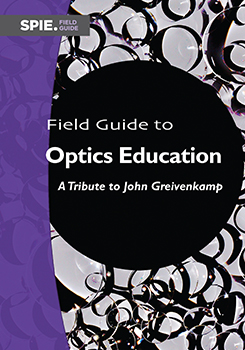Notes on Photonic Concepts and Ideas vs. Algebra
Brian Culshaw
University of Strathclyde, United Kingdom
Photonics is a fascinating subject, principally because it is the only branch of physics that we can see! There are also countless useful equations, which tend to dominate the teaching process. However, the fact that we can see light is a powerful tool in teaching, understanding, and using photonics. Among the phenomena we can see and use, we have scattering of light and diffraction, focusing of light, and reflection and refraction. Let’s spend a little time exploring a few examples. We also need a few kit pieces to illustrate concepts. A laser pointer can be used for much more than putting a dot on a projector screen, and a magnifying glass is also a very good contributor.
In a homogeneous medium, light obligingly travels in a straight line. Usually, the air we breathe is homogeneous enough to make the point—although even shining your laser pointer through a darkened room illustrates that we can, after all, see scattered light, which tells us where the laser beam is traveling. This is a very useful accidental tool by which to visualize light rays and trace the path they take.
The same tool—the laser pointer—also obligingly illustrates refraction at media interfaces, diffraction gratings, and the impact of a variety of diffracting media, for example, some thinly woven cloth; there’s some in every household. You’ll very easily see the impact of spacing on direction. Stretch some partially transparent cloth—your shirt or blouse, for example—and see how the diffraction angle changes as the tension increases and/or changes direction.
Refraction is a little more evasive—simply because you’re really looking for a change in the direction of a light beam as it reaches an interface. However, a little imagination soon gives some straightforward examples. Even a pane of glass can give some insight when light is incident at an angle to the glass surface then that angle changes by the amount by which the beam moves—including incident perpendicular to the surface when the beam doesn’t change direction at all!
These are but a few examples of how the essential concepts of optics—reflection, diffraction, and refraction—can be readily demonstrated using everyday equipment. It also helps all concerned to see and expect the results of an illumination source on the object you see and the light reflected or scattered from it. The general idea is to raise awareness among all concerned of the simple observation that the sometimes apparently complex concepts of optics are in the everyday environment. See the light!!!
The see-to-teach-and-use factors:
See:• Light travels in straight lines except for scatter and refraction.
• Scatter can be seen in even slightly dusty, but otherwise transparent, media.
• Refraction can be seen, too.
• Color and color changes—combinations of material and illumination—can be perceived.


